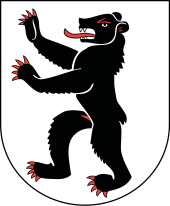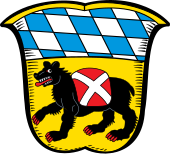
Back Bär (Wappentier) German Oso en heráldica Spanish Ours (héraldique) French Orso (araldica) Italian Lokys (heraldika) Lithuanian Медведь в геральдике Russian Ведмідь (геральдика) Ukrainian

The bear as heraldic charge is not as widely used as the lion, boar or other beasts.
In England it occurs mostly in canting arms, e.g. in the familial coats of arms of Barnard, Baring, Barnes, Bearsley, etc. In British and Irish heraldry, a bear's head is usually muzzled (reflecting the lack of wild bears in those islands), and is more commonly used as a charge than the whole beast. In England and Ireland, the bear's head traditionally includes the neck, while in Scottish heraldry bear heads are cut off close behind the ears.[1]
The bear in the coat of arms of Berlin is also used cantingly, and appears in representations of the Berlin coats of arms in the early modern period (used alongside the Prussian and Brandenburg eagles until the early 20th century).[2] Also canting, but associated with a legendary false etymology of the city's name, is the bear in the coat of arms of Bern.[a]

At the Battle of Las Navas de Tolosa in 1212 between Alfonso VIII of Castile and the Almohads, the council of Madrid sent a detachment in support of the Christian king. According to chronicles of the time, these troops carried a flag or banner which identified them: a statant bear on a silver field.

The bear is also used in arms representing Saint Gall, based on a legend of the saint involving a bear.[3] This is the origin of the bear in the coat of arms in the Abbey of Saint Gall and of Appenzell. The bear of Appenzell is represented pizzled; omission of the bear's penis from the coat of arms of Appenzell was seen as a grave insult, and was notoriously forgotten by the printer of a calendar printed in Saint Gallen 1579, which brought Appenzell to the brink of war with Saint Gallen.[4][5][6]

The saddled bear of Saint Corbinian's legend is the heraldic symbol of Freising, Bavaria, and the Diocese of Munich and Freising. Pope Benedict XVI, former archbishop of Munich, also applied it in his Papal Arms.

In 1666 a polar bear on a blue field was added to the greater/royal arms of the king of Denmark to represent Greenland. It has since then been adopted by Greenland itself as its coat of arms, with the current version having been adopted in 1989. The Greenlandic version bucks European heraldic tradition in favour of Inuit custom by having the bear's left arm raised rather than the right; when used in Denmark the right is raised. It is officially blazoned Azure, a polar bear rampant argent and as such neither version contradicts the other.
- ^ Arthur Charles Fox-Davies, A Complete Guide to Heraldry, London (1909), p. 198
- ^ Werner Vogel, Berlin und seine Wappen. Ullstein, Berlin 1987
- ^ "St Gall's Bear". www.carnalea.down.anglican.org.
- ^ Neubecker, Ottfried (1976). Heraldry : sources, symbols, and meaning. New York: McGraw-Hill. p. 120. ISBN 9780070463080.
- ^ Strehler, Hermann (1965). "Das Churer Missale von 1589". Gutenberg-Jahrbuch. 40: 186.
- ^ Grzimek, Bernhard (1972). Grzimek's Animal life encyclopedia. Vol. 12. New York: Van Nostrand Reinhold Co. p. 119.
© MMXXIII Rich X Search. We shall prevail. All rights reserved. Rich X Search